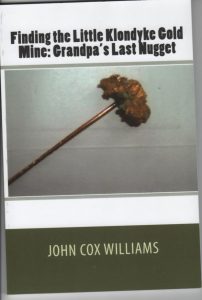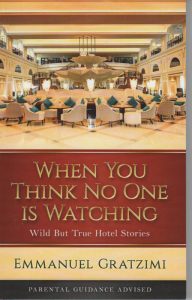Historical Research: Mining for Gold
I am sometimes asked to speak on historical research for writers because of my two historical novels, Shadow of the Rock and In Rembrandt’s Shadow. I visited libraries and special collections, traveled to sites in Florida, St. Thomas, Morocco, and Gibraltar, consulted maps and long out-of-print books, and interviewed historians and others to collect the information I needed. It was quite an adventure.
So I pay attention to the resources used in offbeat research and not necessarily by academics. Recently, a slim book  called Finding the Little Klondyke Gold Mine: Grandpa’s Last Nugget by John Cox Williams crossed my desk. It’s the author’s story of searching for and finding his grandfather’s gold mine. He started with a vague memory of his mother showing him a nugget from the mine. She didn’t say that it was in Nova Scotia or even that it was in Canada, but the author decided to try to find the mine, and the book is the story of how he actually located it, then the trek he took with his grandson to visit the site. He wrote it for his family, but he includes step by step descriptions of how he found the mine, making it a handy research tool for us writers as well.
called Finding the Little Klondyke Gold Mine: Grandpa’s Last Nugget by John Cox Williams crossed my desk. It’s the author’s story of searching for and finding his grandfather’s gold mine. He started with a vague memory of his mother showing him a nugget from the mine. She didn’t say that it was in Nova Scotia or even that it was in Canada, but the author decided to try to find the mine, and the book is the story of how he actually located it, then the trek he took with his grandson to visit the site. He wrote it for his family, but he includes step by step descriptions of how he found the mine, making it a handy research tool for us writers as well.
Speaking of gold and research, Ship of Gold in the Deep Blue Sea by Gary Kindler, first published in 1998, became a bestseller and is still available. It’s what I consider a manual on how to locate, claim, and salvage the gold aboard a sunken ship. It goes beyond that to the legal issues involved as well. It’s the story of the sinking of the SS Central America, a side-wheel steamer carrying nearly 600 passengers returning from the California Gold Rush. It sank 200 miles off the Carolina coast in September 1857. Over 400 lives and 21 tons of California gold were lost in the worst peacetime disaster at sea in American history.
In the 1980s, a young engineer from Ohio set out to establish a working presence on the deep ocean floor and open it to science, archaeology, history, medicine, and recovery. The SS Central America became the target of his project. After years of intensive efforts, Tommy Thompson and the Columbus-America Discovery Group found the Central America in 8000 feet of water, and in October 1989 they sailed into Norfolk with her recovered treasure: gold coins, bars, nuggets, and dust, plus steamer trunks filled with period clothes, newspapers, books, journals, and even an intact cigar sealed under water for 130 years.
 Mining book festivals can also turn up gems in the form of books by people wanting to share their experiences, whether it’s from their research, occupation, travels, or some other happening. Have you ever wondered what the security guard at a luxury hotel might run into? I’ve got a book for you called When You Think No One Is Watching: Wild But True Hotel Stories by Emmanuel Gratzimi, who worked in security for these hotels. A note on the cover advises parental guidance. The author often lapses into copspeak and the book needs a good editor, but the stories are still appalling, funny, tragic and if I were to write about life in a hotel, I have some authentic stories to adapt to mine.
Mining book festivals can also turn up gems in the form of books by people wanting to share their experiences, whether it’s from their research, occupation, travels, or some other happening. Have you ever wondered what the security guard at a luxury hotel might run into? I’ve got a book for you called When You Think No One Is Watching: Wild But True Hotel Stories by Emmanuel Gratzimi, who worked in security for these hotels. A note on the cover advises parental guidance. The author often lapses into copspeak and the book needs a good editor, but the stories are still appalling, funny, tragic and if I were to write about life in a hotel, I have some authentic stories to adapt to mine.
Here’s another interesting title discovered at a book festival. The Scalpel’s Edge: The Culture of Surgeons by Pearl Katz. The author is an anthropologist who I guess turned down Samoa or the Congo for the operating room. This book describes in detail what surgeons actually do in and out of surgery. It reveals how they think and; how their thinking is often non-scientific; how they make decisions; and how they keep secrets from patients and colleagues. This book gives a detailed description of a professional culture and how the culture, especially their active posture, influences decisions which affect patients and the health care system. Sounds like a good bet for a medical thriller.
We writers try to make our stories sound as authentic as possible. Someone somewhere has the experience or expertise to help. Look for these stories.
Eileen McIntire
Eileen has ridden a camel in the Moroccan Sahara, fished for piranhas on the Amazon, sailed in a felucca on the Nile, and lived for three years on a motorsailer, exploring the coast from Annapolis to Key West. Eileen has many years experience writing, editing and designing all manner of publications for nonprofits and professional associations. She is now co-owner of Summit Crossroads Press, which publishes books for parents, and its fiction imprint, Amanita Books. The inspiration for her 90s Club mystery series springs from meeting a slim, attractive woman at a pool party who was the only one actually in the pool swimming laps, and she was 91 years old. Since then, Eileen has collected articles about people in their 90s—and 100s—who are still active, alert and on the job. She often speaks at retirement villages on “Old Dogs, New Tricks.”